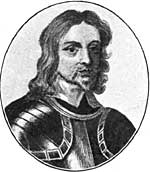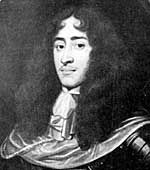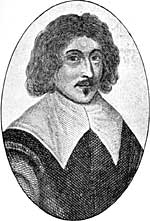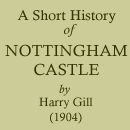< Previous | Contents | Next >
Soon after the surrender of King Charles on May 6th, 1646, at the Saracen’s Head, Southwell, the garrison at Nottingham was reduced, and Colonel Hutchinson retired to his country residence at Owthorpe, but not without first dismantling the Castle, at which Oliver Cromwell, when he came, to the town and saw what had been done, was “heartily vexed.” In 1651 the Council of State made an order for Nottingham Castle to be demolished, and instructions were sent to the Governor, Major Thomas Poulton, “to see it effectually done within 14 days, so that the Castle and all the outworks and fortifications be altogether demolished before the 10th November.”
The whole of the arms, ammunition and moveables had been sent to the Tower of London, and indications are clearly to be seen in the fragments of masonry that remain that the walls were blown down with gunpowder. During the next 20 years, until the site was acquired by the Duke of Newcastle, the dismantled ruin became a common quarry for the townspeople and a prey to the devastating influences of time and weather.
Seeing that the town and county became the scene of such important episodes in the struggle—the first being the raising of the standard on Nottingham Castle and the last the capitulation, at the request of the King, of the garrison at the neighbouring Castle of Newark, followed by the surrender of the King himself at the Saracen’s Head, Southwell—it will not be out of place to give here a brief notice of some of the leading men who took part in it.
Let us first look at a copy of the death-warrant:—
"Whereas Charles Stuart, King of England, is and standeth convicted of high treason and other crimes: and sentence on Saturday last was pronounced against him by this court, to be put to death by severing his head from his body, of which sentence execution yet remains to be done. These are therefor to will and require you to see the said sentence executed in the open street before Whitehall upon the morrow, between the hours of ten in the morning and five in the afternoon, of the said day with full effect, and for so doing this shall be your sufficient warrant.
And these are to require all officers, soldiers and others, the good people of England to be assisting you in the service.
| To Colonel Francis Hacker | |
| Colonel Huncks | and to every of them. |
| Lieutenant Colonel Phayer | |
| Given under our hands and seals.” | |
Then follow the signatures of 59 Commissioners, 4 of whom lived in the county within a radius of 10 miles from the Castle.

General Henry Ireton.

Colonel John Hutchinson.

Francis Hacker.
(1) HENRY IRETON, born at Attenborough, in the house standing close by the church at the west end (the present structure was built upon the old foundations). The record of his baptism may be seen in the church register. He married Cromwell’s daughter Bridgett, and took a leading part in the affairs of the Commonwealth. He died in Ireland after the siege of Limerick at the early age of 42, and was buried in Henry VII.’s Chapel at Westminster. After the Restoration the tomb was destroyed and the body exhumed and hung at Tyburn.
(2) GILBERT MILLINGTON, of Felley Abbey, tried and convicted for complicity in the death of the King. He pleaded for mercy, and his sentence was commuted to imprisonment for life. Died in prison, place and date unknown.
(3) COLONEL JOHN HUTCHINSON of Owthorpe, the famous Governor of Nottingham and its Castle, whose life and deeds are well known. The inscription on his tomb in the quaint little church at Owthorpe records that “He died at Sandown Castle in Kent after ij. months harsh and strict imprisonment without crime or accusation, upon the nth day of September, 1663, in the 49th year of his age, full of joy in assured hope of a glorious resurrection.”
(4) EDWARD WHALLEY, of Screveton, son of Cromwell’s “Aunt Fanny,” his mother being Frances, daughter of Sir Henry Cromwell. He distinguished himself in the wars, and to him was given the custody of the King prior to his execution. At the Restoration, Whalley and his son-in-law Colonel Goffe had to flee the country, and died in exile in America.
Colonel Francis Hacker, into whose hands the warrant was given, and whose duty it was to make arrangements for, and to conduct the King to execution, lived at East Bridgford. At the Restoration the Colonel was placed under arrest, and the warrant for the King’s execution was brought from East Bridgford Hall—some authorities say by his wife—and produced in evidence against him. He shewed great fortitude and courage during his trial, and was subsequently executed at Tyburn October 19th, 1660.
Another well-known character who influenced the course of events at this time by his teaching and writings lies buried in the interesting little church at Ault Hucknall, on the confines of Hardwick Park, just over the border of the county. Thomas Hobbes, “the doubting philosopher,” sometimes called “Hobbes of Malmesbury,” author of “The Leviathan” and other political works on the science of government, spent the latter part of his long and chequered life at Hardwick Hall as tutor to the sons of the Earl of Devonshire. His grave is in the south aisle of the old church, and the Latin epitaph inscribed upon his tombstone may be translated as follows:—“Here buried are the bones of Thomas Hobbes of Malmesbury, who for many years served two Earls of Devon: an upright man well known for his learning at home and abroad. He died in the year of our Lord 1647, on the 4th day of December, in the gist year of his age.”
